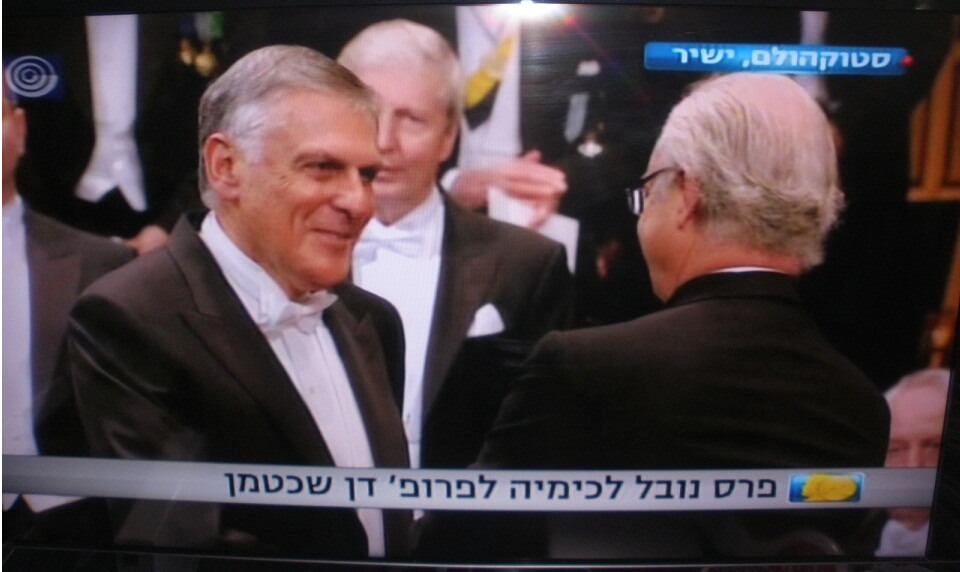The words of thanks of the winner of the Nobel Prize in Chemistry for 2011, Research Professor Dan Shechtman from the Faculty of Materials Engineering at the Technion, at the Nobel Ball held after the awarding ceremony in Stockholm

His Highness, Nobel laureates, my fellow scientists, ladies and gentlemen, my dear family.
On April 8, 1982, sitting alone in the electron microscopy room, I discovered the icosahedral phase, a discovery that marked the beginning of the field of quasi-periodic crystals. Today, however, I stand before you surrounded by hundreds of enthusiastic scientists. I stand here as a pioneer of quasi-crystal science, but without all those many passionate scientists this science would not have become what it is. We are all now celebrating the ultimate recognition of the science we have uncovered.
The people who helped establish the field were few. The first was Ilan Blach, in those days a professor at the Technion, who proposed the first icosahedral model. He showed, through computer simulation, that this structure creates diffraction patterns that match the diffraction patterns I obtained in the electron microscope. Together we wrote the first message about the discovery. John Kahn from the USA and Denis Gratias from France joined us in writing the second, improved article that was published first. Other people who had a substantial contribution to the field are Roger Penrose from England, who years earlier created a non-periodic mosaic based on only two rhomboid tiles, and Alan McKay from England, who showed that Penrose tiles form sharp diffraction spots. Dov Levin from Israel and Paul Steinhart from the USA linked my diffraction patterns to McKay's work. They published a theoretical paper showing the basis for quasi-crystals and coined this term. These pioneers paved the way to the wonderful world of quasi-periodic materials.
I would like to mention two more important scientists who are no longer with us, but their dedication to the field was invaluable. These are Louis Michel, an important French mathematician, and the Chinese Cassin Cao, one of the leading figures in electron microscopy, who received his education in Sweden.
We are approaching the end of the year 2011, which UNESCO declared as the Year of Chemistry - a worldwide celebration of the achievements of chemistry and its contribution to the well-being of mankind. In a few weeks we will find 2012, the centenary year of von Laue's experiment, the beginning of crystallography, the science of crystals. The following year, 2013, will be the International Year of Crystallography. The Nobel event, which is the ultimate recognition in the science of quasi-periodic crystals, occurs in wonderful timing between these two world events dedicated to chemistry and crystallography.
The discovery of the quasi-periodic crystals, and the development of this field following the discovery, caused a paradigm shift in crystal science. The previous definition of the crystal was replaced by a new definition - a wonderful and modest definition that is open to new discoveries. A humble scientist is a good scientist. Science is the best tool for revealing the laws of nature, and the only word written on its banner is truth. The laws of nature are neither good nor bad. What is important is how we harness them to our needs.
Therefore, it is our duty as scientists to promote education, rational thought and tolerance. In the real world the politicians decide for us, but we have to keep an eye on them all the time. We must encourage the educated youth to become entrepreneurs in the technological field. Countries that cultivate this knowledge will survive financial and social crises. Let's promote science and thus create a better world for all of us.
I would like to thank the scientists who submitted my nomination, the Nobel Prize Committee and the Nobel Foundation for the ultimate recognition of our science, and for the great honor that has fallen on my part.
Special thanks to Madeline Brolan, Annika Pomtikis and Annika Moberg, who made this busy week such a fun time for me and my family.
Thank you.

2 תגובות
http://www.youtube.com/watch?v=TmGvqQB9JDI
The poet - Professor Irad Yavne
Sitting from left to right:
Haifa Mayor Yona Yahav
Swedish Embassy in Israel
Nobel laureate Danny Shechtman
Technion president Peretz Lavi
The instructor - Dean of the Faculty of Materials Engineering Wayne Kaplan